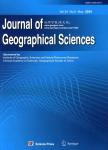城市群地区环境胁迫的驱动因素与时空效应——来自京津冀地区的证据
Driving factors and spatiotemporal effects of environmental stress in urban agglomeration: Evidence from the Beijing-Tianjin-Hebei region of China作者机构:Key Laboratory of Regional Sustainable Development ModelingInstitute of Geographic Sciences and Natural Resources ResearchCASBeijing 100101China College of Resources and EnvironmentUniversity of Chinese Academy of SciencesBeijing 100049China College of Resource Environment and TourismCapital Normal UniversityBeijing 100048China
出 版 物:《Journal of Geographical Sciences》 (地理学报(英文版))
年 卷 期:2021年第31卷第1期
页 面:91-110页
核心收录:
学科分类:0709[理学-地质学] 08[工学] 083305[工学-城乡生态环境与基础设施规划] 083301[工学-区域发展与规划] 0704[理学-天文学] 0833[工学-城乡规划学]
基 金:National Natural Science Foundation of China,No.41971164, No.42071148 Strategic Priority Research Program of the Chinese Academy of Sciences,Grant No.XDA23020101。
主 题:environmental stress spatiotemporal effects driving factors urban agglomeration major functional zones(MFZ) Beijing–Tianjin–Hebei region
摘 要:Environmental stress is used as an indicator of the overall pressure on regional environmental systems caused by the output of various pollutants as a result of human activities. Based on the pollutant emissions and socioeconomic databases of the counties in Beijing–Tianjin–Hebei region, this paper comprehensively calculates the environmental stress index(ESI) for the urban agglomeration using the entropy weight method(EWM) at the county scale and analyzes the spatiotemporal patterns and the differences among the four types of major functional zones(MFZ) for the period 2012–2016. In addition, the socioeconomic driving forces of environmental stress are quantitatively estimated using the geographically weighted regression(GWR) method based on the STIRPAT model framework. The results show that:(1) The level of environmental stress in the Beijing–Tianjin–Hebei region was significantly alleviated during that time period, with a decrease in ESI of 54.68% by 2016. This decrease was most significant in Beijing, Tangshan, Tianjin, Shijiazhuang, and other central urban areas, as well as the Binhai New Area. The level of environmental stress in counties decreased gradually from the central urban areas to the suburban areas, and the high-level stress counties were eliminated by 2016.(2) The spatial spillover effect of environmental stress increased further at the county scale from 2012 to 2016, and spatial locking and path dependence emerged in the cities of Tangshan and Tianjin.(3) Urbanized zones(development-optimized and development-prioritized zones) were the major areas bearing environmental pollution in the Beijing–Tianjin–Hebei region in that time period. The ESI accounted for 65.98% of the whole region, where there was a need to focus on the prevention and control of environmental pollution.(4) The driving factors of environmental stress at the county scale included population size and the level of economic development. In addition, the technical capacity of environmental waste disposal, the intensity of agricultural production input, the intensity of territorial development, and the level of urbanization also had a certain degree of influence.(5) There was spatial heterogeneity in the effects of the various driving factors on the level of environmental stress. Thus, it was necessary to adopt differentiated environmental governance and reduction countermeasures in respect of emission sources, according to the intensity and spatiotemporal differences in the driving forces in order to improve the accuracy and adaptability of environmental collaborative control in the Beijing–Tianjin–Hebei region.



